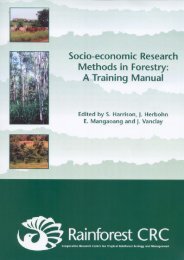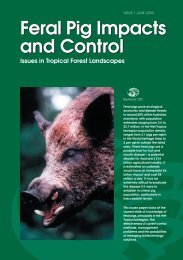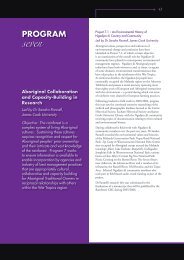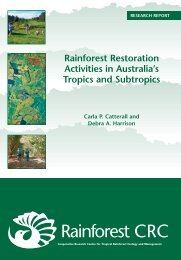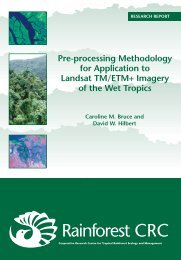Reconciling Nature and Culture in a Global Context? - Rainforest ...
Reconciling Nature and Culture in a Global Context? - Rainforest ...
Reconciling Nature and Culture in a Global Context? - Rainforest ...
Create successful ePaper yourself
Turn your PDF publications into a flip-book with our unique Google optimized e-Paper software.
<strong>Reconcil<strong>in</strong>g</strong> <strong>Nature</strong> <strong>and</strong> <strong>Culture</strong> <strong>in</strong> a <strong>Global</strong> <strong>Context</strong>?Lessons from the World Heritage ListThe relationship posited between maps <strong>and</strong> l<strong>and</strong>scapes approximates the Ptolemicconnection between geography, the representation of the ‘whole known world’ (Gibson 1989:52) <strong>and</strong> chorography, which emphasises limited sections of the world or regions 60 . Thus,regional maps were described as l<strong>and</strong>schaffen or ‘shaped l<strong>and</strong>s’ (Haber 1995: 38) <strong>and</strong> theirproduction constituted an exercise <strong>in</strong> chorography. It would seem that prior to the late1400s, there is no s<strong>in</strong>gle term to describe pictorial representations of natural scenery. Theterm l<strong>and</strong>scape came <strong>in</strong>to use at this time as a way of designat<strong>in</strong>g the details, which madeup the background of a pa<strong>in</strong>t<strong>in</strong>g 61 .The perceived aff<strong>in</strong>ity between l<strong>and</strong>scapes <strong>and</strong> maps is also captured <strong>in</strong> the word‘l<strong>and</strong>scape’ itself. Gibson <strong>in</strong>forms us that <strong>in</strong> many European languages, the term signifies “aprov<strong>in</strong>ce, a district or, more generally, any extensive area of l<strong>and</strong>” (1989: 53). As Haberpo<strong>in</strong>ts out, “the term ‘l<strong>and</strong>scape’ comb<strong>in</strong>es ‘l<strong>and</strong>’ with a word of ancient Germanic orig<strong>in</strong>, theverb ‘scapjan’” (1995: 38). In the evolution of Germanic languages, ‘scapjan’ became‘schaffen’ though it still reta<strong>in</strong>ed its orig<strong>in</strong>al mean<strong>in</strong>g, ‘to shape’ (Haber 1995: 38). As Haberobserves, this shap<strong>in</strong>g of the l<strong>and</strong> was largely regarded as the outcome of “natural agents orforces” (1995: 38), <strong>and</strong> thus l<strong>and</strong>scapes were seen as ‘natural vistas’ <strong>in</strong> their own right orwere presented as a ‘natural’ backdrop to fore-grounded human activities.The concept of l<strong>and</strong>scape we are familiar with today is of l<strong>and</strong>scape as a pictorial subjectmatter rather than as a geographical region. However, the regional connotation of the wordl<strong>and</strong>scape still persists <strong>in</strong> terms of the scope or prospect of the subject matter. Although theconcept of l<strong>and</strong>scape has been unhooked for some time from its orig<strong>in</strong>al art associations(see Bender 1995; Hirsch <strong>and</strong> O’Hanlon 1995), there is still a dom<strong>in</strong>ant view of l<strong>and</strong>scape asan <strong>in</strong>scribed surface, ak<strong>in</strong> to a map or a text, from which cultural mean<strong>in</strong>g <strong>and</strong> social formscan simply be read.Susan Kuchler refers to the view of l<strong>and</strong>scape as <strong>in</strong>scribed or associated surface as the“l<strong>and</strong>scape of memory”, where<strong>in</strong> memories (or mean<strong>in</strong>gs) are somehow captured <strong>in</strong> orrepresented by the form of visual l<strong>and</strong>marks. Kuchler po<strong>in</strong>ts out that <strong>in</strong> this view, the idea ofl<strong>and</strong>scape is not “affected by the project of its representation <strong>and</strong> remembrance” (1995: 104).Kuchler contrasts this view of l<strong>and</strong>scape as the encod<strong>in</strong>g of memory <strong>and</strong> mean<strong>in</strong>g with thenotion of “l<strong>and</strong>scape as memory” (1995: 85). In this perspective, l<strong>and</strong>scape is implicated <strong>in</strong>both the dynamic <strong>and</strong> <strong>in</strong>teractive social processes of memory-mak<strong>in</strong>g as well as be<strong>in</strong>g one ofthe products of these ongo<strong>in</strong>g processes.The historian Paul Carter is another scholar who takes issue with the idea of space as abackdrop or stage upon which significant events, such as European discovery or anIndigenous ‘Dreamtime’ take place. Similarly, Carter is critical of a view, which presentsphysical surround<strong>in</strong>gs as merely this. As Carter po<strong>in</strong>ts out <strong>in</strong> his book ‘The Road to BotanyBay’, what is symbolised is not ‘the physical country’ per se but “the enactment of [analready] historical space” (1987: 349). In other words, references to such th<strong>in</strong>gs as physicalcountry can only be made by means of the cultural representations of those th<strong>in</strong>gs. Carterdraws our attention to the importance of realis<strong>in</strong>g that a l<strong>and</strong>scape, whether Indigenous orEuropean, signifies more than just another way of represent<strong>in</strong>g or symbolis<strong>in</strong>g geographicalentities or natural surround<strong>in</strong>gs. Indeed, representation constitutes just one facet of people’s60 The Dutch concept of l<strong>and</strong>schap orig<strong>in</strong>ally referred to a small area of l<strong>and</strong>, which was viewed as an<strong>in</strong>set of a much larger region or context. The concept of chorography emerged as a way ofrepresent<strong>in</strong>g <strong>and</strong> talk<strong>in</strong>g about this form of conf<strong>in</strong>ed perspective. In this respect, l<strong>and</strong>schapco<strong>in</strong>cides with the German mean<strong>in</strong>g of the word L<strong>and</strong>schaft (see Bender 1995: 2).61 Gibson (1989: 53) records that it was common practice <strong>in</strong> contracts between artists <strong>and</strong> theirpatrons for a detailed <strong>in</strong>ventory to be drawn up which referred to all of the elements, which would be<strong>in</strong>corporated <strong>in</strong>to the f<strong>in</strong>al pa<strong>in</strong>t<strong>in</strong>g.63




